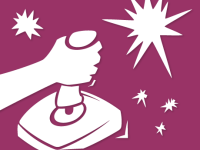Strategies to Level Up Learning
The platform model of game-based learning resources can help non-gaming teachers vet appropriate classroom games, provide student performance analytics, and include lesson plan ideas.
Your content has been saved!
Go to My Saved Content.In the fall of 2014, the Joan Ganz Cooney Center at Sesame Workshop (a nonprofit founded by Sesame Street creator Joan Ganz Cooney) assessed the impact of the gaming in school settings. The report was titled Level Up Learning: A National Survey on Teaching with Digital Games by Lori Takeuchi, Ph.D., and Sarah Vaala, Ph.D.
About 700 K-8 teachers took part in the study, so it serves as a snapshot of game-based learning implementation. The report found that 82 percent of teachers surveyed played games in their free time, and 78 percent of that group (referred to as GUTs, or game-using teachers) use games to teach. The report next compared GUTs to NUTs, or non-game-using Teachers. (Yes, you read that right!) NUTs were not entirely resistant to teaching with games. However, the percentage that utilized games to teach was smaller: 55 percent. These findings may signify that a teacher who has experience playing games may be more apt to teach with them.
Of course, people play different games for different reasons. GUTs reported that some games were more effective than others as learning tools. The researchers also stratified the groups of teachers to subcategories, ranging from "dabblers" to "naturals." Additional teacher training, as well as creating a common language between educators and developers, was recommended. To read the entire report or just the executive summary, click here.
Lowering Barriers for Non-Gaming Teachers
It can seem confusing to find an effective and engaging digital game to bring into a classroom. There is no ubiquitous model to follow. While Apple's App Store and Android apps on Google Play offer digital distributions, the categories of content can seem overwhelming. For example, the App Store has many gaming categories ranging from role-playing to strategy to trivia. A search for "math games" listed flashcard apps right next to the innovative Dragon Box algebra game. To a non-gamer, a content-driven experience seems more appropriate, when in fact more authentic options exist.
Solutions are emerging, such as the "platform" model. Similar to how Facebook features games playable across its social media network, websites can do the same for learning games. Platforms typically vet games for classroom use, provide real-time analytics on student performance, and include lesson plan ideas. (Of course, not all platforms are the same. Many still exist that highlight chocolate-covered broccoli games. However, this blog post serves to share best practices, not to criticize providers of content.)
One platform of note is from GlassLab (the nonprofit Games, Learning, and Assessment Lab initiative). It launched SimCityEDU in 2013, followed by the tablet game Mars Generation One: Argubot Academy in 2014. Both titles are Common Core-linked, playable via a single login, and include a teacher dashboard feature. Student competencies are reported to the teacher as a formative assessment of gameplay. For example, mastering SimCityEDU signifies student ability to manage cause-and-effect relationships. Argubot Academy informs the teacher about student ability to use claims and evidence in argumentation.
At the Games for Change Festival last spring, GlassLab announced that its analytics would host third-party applications (titles developed from other companies). The first was iCivics' Argument Wars. This winter, Math Snack's Game Over Gopher was added. More games are planned for 2015. Its growth as a platform has led EdSurge (an educational technology resource website) to compare GlassLab to Steam, the streaming game service from Valve (Team Fortress 2).
BrainPOP’s GameUp is another place to find and play learning games. All games are playable right in a computer’s browser -- no downloads or installations required. Each game is sorted into different disciplines and includes lesson plan materials. Via its SnapThought Photo Reflection Tool, students can answer reflection questions about decisions made and problems solved during play. Aside from third party titles -- including award winners Mission U.S. and Quandary -- it also has original content. One example is Sortify, in which students choose from topics, like parts of angles, oceans, or musical instruments, and then drag-and-drop items into categorized bins.
Creating a Common Discourse
In my research on game-based learning, I often find myself checking the GamesandLearning.org portal. Launched by the Cooney Center, it features original and aggregated news items about educational games. The website is a one-stop sandbox for articles from both the developer's and educator's points-of-view. There is an "Explainer" tool, which sorts out educational and industry jargon. For example, a non-gamer may not know what an RPG (role-playing game) is -- even though role-play may exist in his or her classroom. Similarly, a game developer may not know the difference between formative and summative assessment strategies.
The gatekeeper of student learning is ultimately the classroom teacher. Lowering a few crucial barriers to non-gaming teachers -- including simple logins, easy-to-use teacher dashboards, as well as teacher training -- may be the simple solutions required to further game-based learning initiatives.
